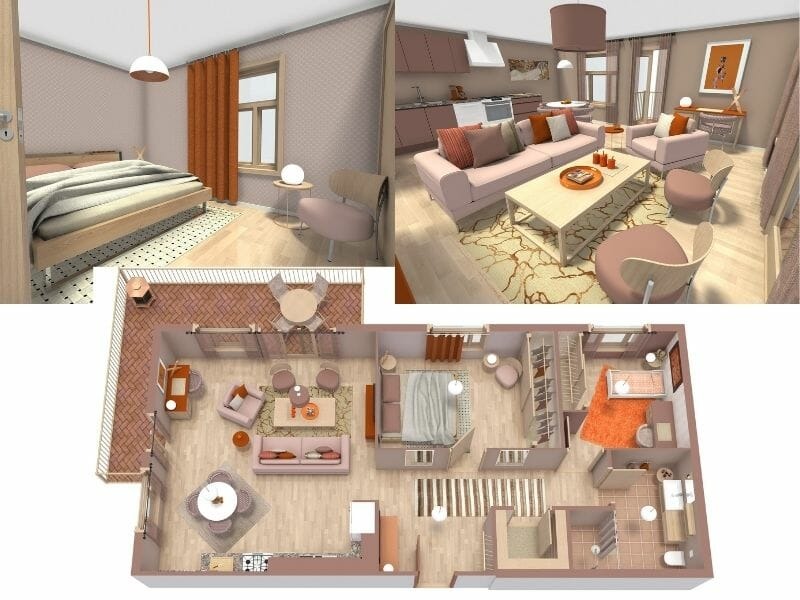Planning an interior design project like a pro involves more than just picking out furniture and colors. It’s about creating a cohesive, functional, and beautiful space that reflects your style and meets your needs. Here’s how to tackle your next design project with confidence:
1. Define Your Goals and Needs
Before diving into the aesthetics, identify the practical needs of the space:
- What’s the room’s primary function? (e.g., living room for socializing, office for work)
- Are there any specific challenges, like small space, awkward layout, or lack of natural light?
- What mood or atmosphere do you want to create? (cozy, modern, tranquil, etc.)
This will give you a clear direction for how you want the space to feel and function.
2. Set a Realistic Budget
Determine how much you’re willing to spend and break it down by category (furniture, paint, lighting, etc.). Be sure to account for unexpected costs, and don’t forget about items like hardware, accessories, or professional services (if needed). Prioritize your spending by investing in key items that will make the most impact (e.g., quality sofa, statement lighting) and saving on others (e.g., inexpensive accessories, DIY projects).
3. Gather Inspiration
Collect images and ideas that reflect your style. Use platforms like Pinterest, Instagram, or design magazines for inspiration. Create mood boards to visualize the overall vibe you want for the space—think about colors, textures, materials, and furniture styles. This will serve as your design blueprint.
4. Measure and Assess Your Space
Accurate measurements are critical. Measure the dimensions of your room, including the height of walls, windows, and doors. Also, account for traffic flow and how much space you need for each function in the room. Consider elements like ceiling height, natural light, and existing features (fireplace, windows, built-in shelving).
5. Create a Layout and Plan
Once you know your space’s dimensions, sketch out a layout for your furniture. You can use online tools or apps like SketchUp, Floorplanner, or even graph paper to experiment with different arrangements. Be mindful of:
- Furniture placement (leave room for easy movement)
- Focal points (TV, fireplace, view)
- Scale (don’t overcrowd the space)
Think about how people will use the space and aim for a functional flow, especially in rooms like living areas and kitchens.
6. Choose a Color Palette
Select a color scheme that complements the mood and purpose of the room. A good rule of thumb is to start with neutral tones for walls and larger furniture pieces, then add accent colors through pillows, artwork, rugs, and smaller accessories. Make sure the colors flow seamlessly from room to room, especially in open-concept spaces.
7. Select Key Pieces First
Pick the largest or most important pieces of furniture first, such as the sofa, dining table, or bed. These items will set the tone for the room. Ensure they are functional, durable, and align with your overall style. Once you have these core pieces, you can fill in with smaller items like side tables, lamps, and art.
8. Incorporate Lighting Strategically
Lighting can make or break a space, so plan it carefully:
- Ambient Lighting: Ceiling lights, chandeliers, recessed lighting for general illumination.
- Task Lighting: Desk lamps, reading lights, or under-cabinet lighting for focused tasks.
- Accent Lighting: Table lamps, sconces, and track lights to highlight features like artwork or plants. Layer different lighting types to create a warm, inviting atmosphere.
9. Add Texture and Layering
Mix different textures to add depth and visual interest:
- Soft textures: Upholstery fabrics, throw blankets, and pillows.
- Hard textures: Wood, metal, glass, and stone.
- Natural elements: Plants, woven baskets, or linen curtains. Layering textures helps balance a room’s visual appeal and keeps the space from feeling flat or one-dimensional.
10. Personalize the Space
Add unique, personal touches to make the space truly your own. Display art, family photos, heirlooms, or travel souvenirs. Consider custom pieces or DIY projects that reflect your style and add authenticity to the design.
11. Plan for Storage and Organization
Storage should be both functional and stylish. Choose furniture with hidden storage (ottomans, coffee tables with drawers, or multi-purpose shelves). Wall-mounted shelves, floating cabinets, and baskets can help reduce clutter while maintaining the aesthetic of the space.
12. Don’t Rush the Process
Interior design is an evolving process. Take your time with the selections, experiment with placement, and don’t be afraid to live with your choices for a while before making final decisions. You may find that a piece of art, a new rug, or a change in lighting completely transforms the feel of the room.
13. Consider Hiring a Professional (If Needed)
If you’re feeling overwhelmed or want a more polished outcome, don’t hesitate to hire a professional designer. They can help you stay within your budget, make design suggestions, and handle things like furniture sourcing and contractor coordination. Many designers offer virtual consultations, so it’s easier to find someone within your budget.
By following these steps, you’ll create a design plan that’s organized and intentional, making the process smoother and more enjoyable. Are you working on a specific room, or is this for an entire home makeover?

